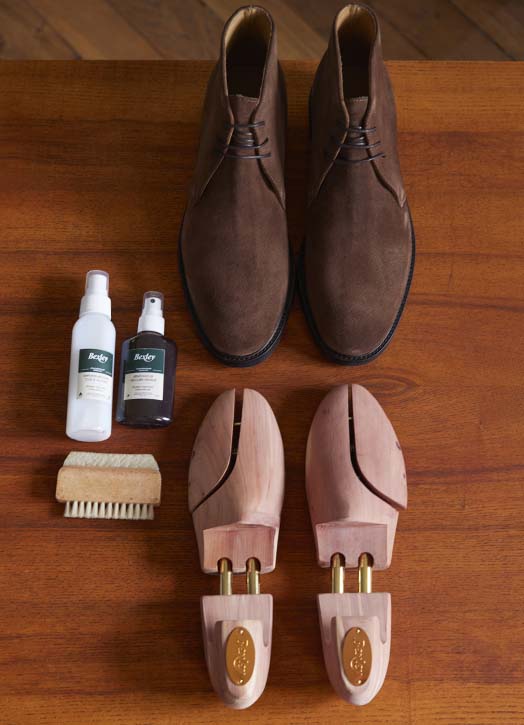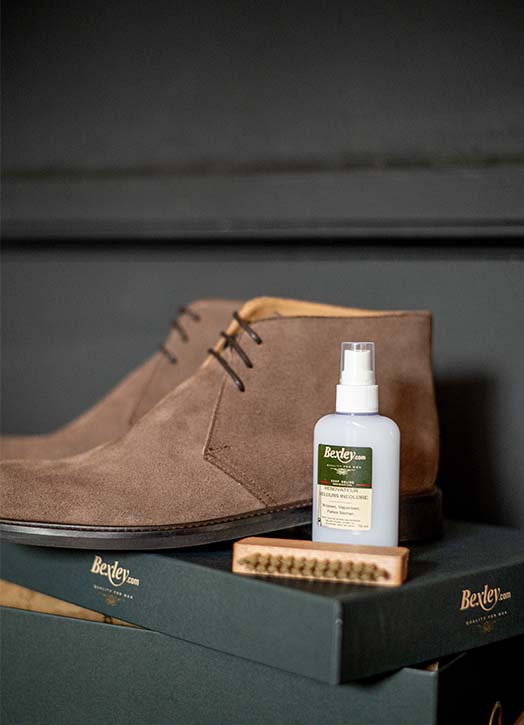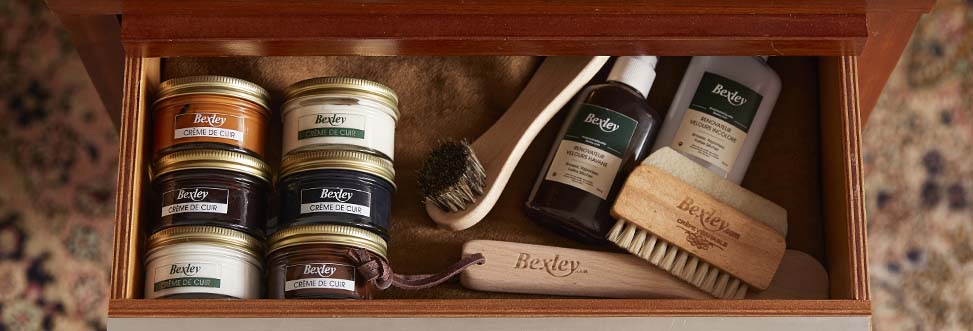- Home
- Guides & Tips
- Shoe guide
- Suede shoe care
How to care for suede/nubuck shoes?
Recognising leather
- What exactly are suede and nubuck leather?
- Velvet leather, nubuck leather, suede – what’s the difference?
The material needed
- What equipment do you need?
- Why use a crepe brush rather than a classic shoe brush?
How to
- How do you clean and restore nubuck shoes?
- Storing a pair of nubuck or suede shoes
Why should you look after your nubuck/suede shoes?
Distinguished and elegant, suede and nubuck leather shoes are an essential accessory for today’s modern gentleman. Always a highly popular choice in autumn and winter, nowadays they are worn all year round, both as driving moccasins and Derby shoes, for wearing with some rolled-up chinos.
But this soft, resistant yet delicate material needs special care. Light coloured nubuck can often get dirty easily, and difficult stains, like greasy substances for example, can be hard to remove whatever the colour. Finally, you’ll need specific products to care for your suede or nubuck leather, as it can’t be cleaned or shined with the same products as smooth leather. Follow the guide!
What exactly are suede and nubuck leather?
Nubuck leather, suede, velvet leather – no doubt you’ve heard all these different terms without knowing exactly what each one refers to. Nubuck is quite simply cow leather that has been finished in a special way. In this particular case, it has been buffed with very fine sandpaper, resulting in a velvety finish that is very soft to the touch.
Velvet leather, nubuck leather, suede – what’s the difference?
The difference between nubuck and velvet leather, or suede, lies in the side that was buffed. Nubuck leather has been sanded on the grain side, i.e. the outer surface. As for suede, this is buffed on the flesh side, or inner surface. In other words, only a trained eye would be able to tell the difference!
As for suede, this word is used for both nubuck and velvet (suede) leather and does not refer to a specific material. The word actually comes from the French word for Sweden, as used in the late 19th century to describe kid gloves from Sweden: “gants de Suède”.
Very much appreciated for its softness and suppleness, nubuck leather is often used to make both shoes and other leather goods. Velvet leather, or suede, meanwhile, is robust and breathable, and may be used for making protective items, such as gloves.


Caring for nubuck and suede shoes: what equipment do you need?
To care for your nubuck leather shoes, you need to assemble the following shoe-care products:
- A set of unvarnished softwood shoe trees
- A crepe brush
- A suede and nubuck renovator
- And a water proofing spray
Why use a crepe brush rather than a classic shoe brush?
If you’ve already spent money on a horsehair brush just to care for your shoes, you may be wondering why you need to buy another brush. But crepe brushes are specially designed for caring for suede and nubuck leather shoes, because they remove dust and dirt without damaging the material.
The crepe itself is just rubber, and it acts like an eraser on the nubuck leather, cleaning it gently yet effectively. The colour of the nubuck might transfer onto the rubber, making it look dirty. But don’t worry!
You can safely use it on other items, it won’t leave a stain. Crepe brushes should not be cleaned, so, no matter what happens: don’t run it under the tap!
How do you clean and restore nubuck shoes?
Next, put your shoes on the shoe trees so that they keep their shape.
1. Cleaning
2. Restoring
3. Brushing
4. Water proofing
Storing a pair of nubuck or suede shoes
Shoe care is not just about brushing, shining or water proofing. And all the shoe care products in the world won’t keep your nubuck and suede shoes in good condition if you don’t look after them each and every day. That’s why how you store them is also of great importance.
Once again, we can’t tell you how highly we recommend using shoe trees made from natural, unvarnished wood. They fulfil a dual function: firstly, they help your shoes to keep their original shape, and stop comfort creases forming, and secondly, they absorb any residual moisture formed during use owing to heat or perspiration.
We advise you to then store them in their original shoebox, in a dark place, away from excess heat. Lastly, if you won’t be wearing the shoes again for several months (when there’s a change of season, for instance), you could also remove the laces. That will prevent the eyelets from going out of shape prematurely, particularly if they are non-reinforced, punched eyelets.

 30 days
30 days 3D SECURE
3D SECURE
